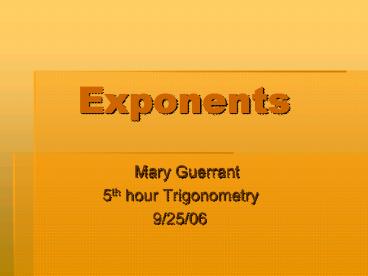Exponents - PowerPoint PPT Presentation
1 / 11
Title:
Exponents
Description:
Any number raised to the power of one equals the number itself. ... notation is written as a product of a number between 1 and 10 and a power of 10. ... – PowerPoint PPT presentation
Number of Views:60
Avg rating:3.0/5.0
Title: Exponents
1
Exponents
- Mary Guerrant
- 5th hour Trigonometry
- 9/25/06
2
Introduction to Exponents
- Exponents are a shorthand way to show how many
times a number, called the base, is multiplied
times itself. A number with an exponent is said
to be "raised to the power" of that exponent. - A base of five raised to the second power is
called "five squared" and means "five times
five." Five raised to the third power is called
"five cubed" and means "five times five times
five." The base can be any sort of number--a
whole number, a decimal number, or a fraction can
all be raised to a power.
3
Rules of Exponents
- Here are some simple rules to use with exponents.
- a1 aAny number raised to the power of one
equals the number itself. - For any number a, except 0, a0 1Any number
raised to the power of zero, except zero, equals
one.
4
Multiplying Exponents
- For any numbers a, b, and c, ab x ac abc
- This multiplication rule tells us that we can
simply add the exponents when multiplying two
powers with the same base.
5
Common Mistakes When Multiplying Exponents
- Mistake! Do not multiply the base and the
exponent. 26 is not equal to 12, it's 64! - Mistake! The multiplication rule only applies to
expressions with the same base. Four squared
times two cubed is not the same as 8 raised to
the power two plus three. - Mistake! The multiplication rule applies just to
the product, not to the sum of two numbers.
6
Scientific Notation
- A number written in scientific notation is
written as a product of a number between 1 and 10
and a power of 10. - Examples7 x 7 x 7 x 7 ? 742 x 2 x 2 x 2 x
2 x 2 ? 26110 1 53 5 x 5 x 5
125 - Write the following numbers in scientific
notation.565,000 5.65 x 1057,325,000
7.325 x 10691,247,000,000 9.1247 x 1010
7
Dividing Exponents
- The quotient rule tells us that we can divide two
powers with the same base by subtracting the
exponents. You can see why this works if you
study the example shown.
8
Negative Exponents
- Any nonzero number raised to a negative power
equals its reciprocal raised to the opposite
positive power.
9
Power of a Product of Factors
- Use the distributive property and multiply the
exponent outside of the parenthesis by each base
inside parenthesis. - (ab)n anbn
10
Power of a Power
- To take a power of a power, multiply the
exponents. - (am)n amn
11
References
- http//www.math.com/school/subject1/lessons/S1U1L8
GL.html - http//www.themathpage.com/alg/exponents.htm
- http//www.purplemath.com/modules/exponent.htm































